30 Sep 2013
by Fergiemoto
in Uncategorized
Tags: art, chronic pain, doodles, emotions, encouragement, haiku, healing, health, pain, poems, poetry, psychology, quotes, sketches
>>:::<<
water
embraces each drop of rain
the ocean hides my tears
>>:::<<
In my creativity blog, I talked about the additional challenges we are facing and the reasons for my scarcity in the blogging world. I am still around, I am doing my best, and I thank you for being patient with me.
Multiple major areas in my life are, quite frankly, in turmoil, and the feeling of overwhelm with all of them happening at the same time is often unbearable and feels like I cannot keep my head above water. But as I realize, change is the only thing that is stable and one must somehow adapt to change, as I wrote about in my last posting. None of these areas, not even details at this point, can be ignored, avoided, or denied, or we risk lagging in improvements. They all need attention, and there is a LOT to be done.
When there is time, I try to apply the tools I have learned (and included in this blog) for addressing emotional and physical pain and anxiety, as this continues to be a very painful time. One thing to keep in mind that I learned from my pain psychologist is that it is important to have a variety of tools to help through pain and anxiety. However, even though he has taught me the tools he knows, he stressed that no amount of tools combined will replace the need for genuine emotional support from other people. Also, it is important to have multiple people to lean on, otherwise, the loss of even one source of support can be devastating.
I hope when you are facing tough times, that you have people you can count on to give you the purity of their attention and compassion.
…also, remember that it is ok to cry.

”Tears expand you, they don’t diminish you.” ~ Michael Ondaatje
The fish said, “I can’t see my tears because I’m in the water.”
The water said, “I can feel your tears because you’re in my heart.”
Lesson: We may hide our own hurts and pains but never can we lie to the people who care about us the most. Words aren’t needed for them to know how we are. (Source: Searchquotes.com)
.
19 Jul 2013
by Fergiemoto
in Uncategorized
Tags: art, chronic pain, creativity, doodles, emotions, encouragement, healing, health, nature, pain, psychology, quotes, sketches
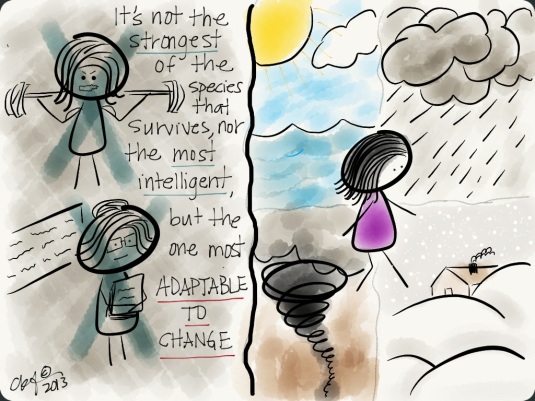
…
It’s not the strongest of the species that survives, nor the most intelligent, but the one most ADAPTABLE to CHANGE.
…
I saw this quote a few days ago and it really hit home. My life is drastically different than it was 10 years ago, even much different than it was five years ago. I will never be able to go back to the life I had so many years ago, and have to keep moving forward, toward adapting to more changes. It’s a necessary acceptance. Some of it is good, while some of it is sad. One thing for certain, though, is that change is constant.
My “normal” keeps changing. I’m sure many of you who visit or follow this blog can relate to how that feels.
Let’s keep forging ahead!
05 Jul 2013
by Fergiemoto
in Uncategorized
.
.
I posted this a few days ago on my other blog, Creativity Aroused. For those of you who follow both of my blogs, I apologize for the duplicate posting.
I have written about the various tools I have learned to use for anxiety. However, the last week in May and the first week in June was a period of such extreme symptoms that no amount of tools in my toolbox were helping with the anxiety. Nothing was working. Sometimes we have periods like that. My therapist suggested distracting myself, even though it may be difficult to do. She said that although being aware of the emotions and feelings in our bodies is important, this was an extenuating circumstance where distraction was appropriate to use. Yes it was difficult, but I started with little steps, and I’ve had her continual encouragement along the way.
The challenges, as I’ve talked about in this reblogged post, continue. So, I will keep her words of wisdom constantly in mind.
 Creativity Aroused
Creativity Aroused
This post is different from what I normally post. Over the last several weeks, I’ve felt like I’ve been in a constant spin cycle, increasing in speed and turbulence due to escalating health problems and other issues. Constant shaking, rapid and forceful heart palpitations, passing out, and intense stomach pains landed me in the emergency room the first week in June, hooked up to several wires and an IV. Eventually the doctor determined the main issue was “extreme stress.” Some of these symptoms still continue.
In my last post, I talked about spending several days in the hospital with my Mother because of an unexpected surgery. That occurred in the middle of June after my own ER visit. Last week, after recuperating with us, she had what we thought would be a routine follow-up with the doctor…
View original post 419 more words
11 Jun 2013
by Fergiemoto
in Uncategorized
Tags: alternative medicine, art, chronic pain, doodles, fragrance sensitivity, haiku, health, MCS, multiple chemical sensitivity, nature, poems, poetry, psychology, sketches
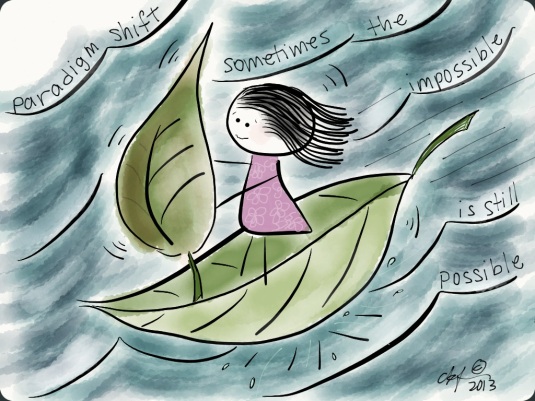
>>:::<<
paradigm shift
sometimes the impossible
is still possible
>>:::<<
>>:::<<
depleted options
yet still crossing rough waters
perseverance
>>:::<<
There are situations where the impossible really is impossible. But there are also times when the seemingly impossible is possible if we can look at those situations from a different angle or perspective. We don’t always have to think of those alternatives on our own. Sometimes a phrase, a comment, or a suggestion from someone else at the right time or place can get us to consider things differently. One does not have to traverse rough waters in a boat if it is not available. Sometimes “leaves” (metaphorically) will get us across.
A couple of examples:
Three years ago, when my doctors told me they “couldn’t do any more for me,” I hadn’t thought about alternative medicine as an option. After hearing the doctors’ dreadful words, I was devastated and thought my situation was hopeless. Was I to remain nonfunctional and debilitated forever? My pain psychologist then suggested I try alternative medicine and said, “What do you have to lose?” He said I needed to stop relying on doctors to provide answers for my undiagnosed conditions, because I kept running into dead ends. He was right. The alternative route has been better, gentler and healthier for those issues.
My fragrance and chemical sensitivities are a struggle because it has lead to increasing isolation and a significantly decreased social life. Although it has made me appreciate nature more, and has resulted in doing more activities in nature, we still try to think of ways where I can get out into society and minimize my exposures at the same time. We still need contact with other people where possible, and I don’t want to live in total recluse. Here are a few ways we have adjusted:
- My hubby and mother are fragrance free 100% of the time, and my two best friends are fragrance free when I’m with them.
- We can have people in our home if they are fragrance free when they come. I can visit friends and family if their home is fragrance free while I am there.
- I can still go out to eat if the establishment isn’t using air fresheners or scented candles, and I am not seated next to others wearing heavier fragrance. I have kindly asked to be moved to a different table before.
- I can go to a movie theatre if it is a matinée (cheaper) and/or the theatre doesn’t have many occupants. That way I can move to a different seat if I have to.
- I can go into shops if they are not using air fresheners or other fragrances.
- I can go to departments stores if I stay away from the perfume and fragrances section.
- Etc., etc., etc.
As I’ve mentioned in previous postings, I still have a long way to go with my health and chronic pain, and I still have rough setbacks, but I have improved from three years ago. I still struggle and get discouraged at times, but I have to remember that in reality, there is still hope and there are still options.
.
What are some examples of where you are using “leaves” instead of “boats” to get across rough waters?
15 May 2013
by Fergiemoto
in Uncategorized
Tags: art, chemical sensitivity, chronic pain, doodles, emotions, encouragement, fragrance sensitivity, health, invisible illness, MCS, migraines, multiple chemical sensitivity, quotes, sketches
May is national MCS (Multiple Chemical Sensitivity) month. Briefly, MCS is defined as suffering “multi-system illnesses as a result of contact with, or proximity to, a variety of airborne agents and other substances.”
According to MCS-America, MCS affects over 48 million men, women and children of all races. There are many substances that affect those with MCS, some of which include fragrances, cleaning products, laundry products, air fresheners and scented candles, secondhand smoke, pesticides, paints, solvents, certain foods, preservatives, beauty and personal care products, etc, etc. Symptoms can range from mild annoyances to life-threatening reactions.
As I wrote in my previous posting about Human Canaries, I am a person who is highly sensitive to low levels of fragrances and chemicals. They make me very sick and I could be debilitated in bed for at least a couple of days after an exposure…and an exposure could be as simple as getting a whiff of someone’s perfume or walking by an air freshener.
FRAGRANCE SENSITIVITY
The remainder of this post will focus mainly on fragrance sensitivities, which is a part of MCS. Studies are suggesting that fragrances are becoming an increasing concern in general, and definitely for me because of its increasing prevalence. There are more and more fragranced products that are available, and more products where the fragrance is designed to last longer (as I have seen in commercials for certain laundry products).
Health Concerns
Research has discovered a number of toxic and undisclosed chemicals in fragranced products. Prior to the 1970s, perfumes were primarily made from natural ingredients like flowers and herbs. However, perfume formulations have since changed. Today, perfumes are over 90% synthetic. These fragrances can contain up to several hundred chemicals, many of which are toxic even at low levels and can be dangerous when inhaled or applied to the skin. Low levels can accumulate and small exposures over time can lead to health problems. Common fragrance chemicals have been found to be toxic to the neurological, respiratory, immune, and endocrine systems. The skin is the largest organ in the body and absorbs chemicals, which can affect other organs in the body. Also, according to the American Academy of Dermatology (AAD), fragrances are considered a leading cause of contact dermatitis.
Fragranced Products
Fragranced products are widely used in homes, businesses, institutions, and public places. Some that are of concern include:
- Laundry products – detergents, fabric softeners and dryer sheets
- Scented candles and air fresheners
- Personal care – soap, shampoo, hairspray, gels, lotions, sunscreen, deodorants
- Perfumes, powders, oils
- Cleaning supplies
Environmental Impact:
Fragrance chemicals enter and persist in the environment. They have been found in the air, soil, water bodies and drinking water, and are difficult and costly to remove once they have entered the environment.
Fragrance Regulation:
The fragrance industry is mainly self-regulated. No law in the United States requires disclosure of any ingredients in a chemical mixture called “fragrance” even if the chemicals are toxic or carcinogenic. Depending on the type of product, the word “fragrance” may not even need to be listed. Certain regulated products only need to list “fragrance” or a similar term, as an ingredient, but not the ingredients that make up the fragrance, even though an individual “fragrance” can contain up to several hundred chemicals. Generally, consumer product ingredients are exempt from disclosure, some of which are protected as “trade secrets.”
Alternatives
There are many resources on the internet that include healthier and environmentally responsible alternatives. Here are just a handful of suggestions:
- Choose products without fragrance, scent or perfume.
- Help institute or suggest a fragrance-free policy at work in consideration of those who are sensitive and become ill.
- Baking Soda – a versatile natural cleaner, scourer, odor absorber, deodorizer, and is a natural fabric softener and deodorizer when added to the wash water prior to adding clothes.
- White Vinegar – another versatile natural cleaner, grease cutter, stain remover, removes mildew, odors, and is a natural fabric softener, deodorizer and reduces static cling when added to the wash or rinse water
- Lemon – has effective antibacterial qualities and can dissolve all sorts of grime.
- Use better ventilation and consider plants that absorb and reduce odors, rather than using a potentially toxic air freshener that masks the odors but does not clean the air.
- Hydrogen peroxide – for cleaning
- Fresh coffee grounds – absorbs odors
- A natural or organic ingredient, or essential oils do not always mean it’s safe. Some can be harmful and emit hazardous chemicals. (Some natural plant smells alone that make me very ill are lavender, gardenia and stronger fragrant flowers.)
Remember, being “clean” does not have a smell, and changing just one thing is a positive step to a healthier environment and healthier living.
Consideration for people with sensitivities
Even for those who do not experience any reactions to chemicals, fragrances, allergens, etc., or do not notice their existence, we might consider healthier alternatives for our own sake, the environment, and for those whose lives are greatly altered and tormented by their presence.
Please be considerate and respectful of those who say they are noticing a fragrance, chemical or allergen that is making them ill, whether it is something wafting in the environment or a product being used by someone they are with. It is a very real problem for us and leads to loneliness and involuntary (or necessary) isolation from relationships and activities that we so much want to be a part of. Personally, my doctor said my only option is to avoid any of my irritants called fragrances and chemicals. Health should be a top priority. Judgmental reactions and criticisms do not help. Some people are so debilitated from what many would consider low or unnoticeable levels that they have had to resort to near total isolation to protect their health. I believe this is the case with some of my blogging friends who have MCS.
Friends, family and others who are considerate, respectful and even stand up for us as an advocate shows us that we are important to them, and that we matter. What an important and necessary feeling to experience!
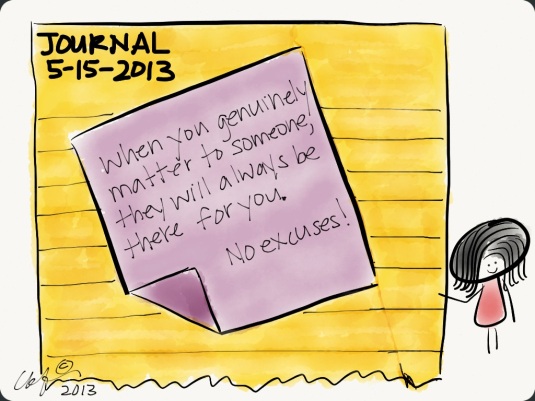
Here is a closing thought to consider: When you genuinely matter to someone, they will always be there for you. No excuses, no lies, no broken promises.
Related articles:
25 Apr 2013
by Fergiemoto
in Uncategorized
Tags: art, chronic pain, doodles, emotions, haiku, health, meditation, pain, poems, poetry, psychology, sketches

>>>::<<<
dark clouds swallow me
relentlessly tormenting
pain monsters
>>>::<<<
Several weeks have passed and the elevated, intense pain symptoms persist. The list of places in my body without pain is shorter than the list of places experiencing pain. This recent increase is explainable. There have been a few unexpected setbacks, and I need to continue therapy, stretches and treatments to get me back on track.
In one of my pain psychology sessions a while back, I showed my psychologist some doodles I had created, which included some emotional situations involving…of course…pain. One of the recommendations he had in addition to doing artwork regarding emotional situations is to draw an alternate scenario. For example, he asked how I would draw myself if I had more “power ” and said that drawing an alternate scenario can help you figure out an alternate in real life. So here it is…my alternate scenario:
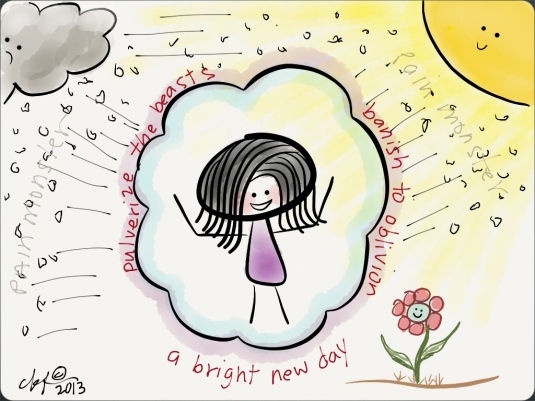
>>>::<<<
pulverize the beasts
banish to oblivion
a bright new day
>>>::<<<
Pain is only one type of monster persisting right now. What kinds of monsters are persisting (or have persisted in the past) for you?
16 Apr 2013
by Fergiemoto
in Uncategorized
Tags: art, chronic pain, doodles, emotions, haiku, health, meditation, pain, poems, poetry, psychology, sketches

>>>::<<<
pain advances
like shadows grow through the day
a new day has not dawned
>>>::<<<
Lately, there has been quite an increase in chronic pain and other symptoms. I hope for the day when decreased pain will give me some freedom and independence. In the meantime, I must continue treatments, therapy, stretches and mind/body exercises, including taking pain breaks with what I call my “nature, photography, and creativity meditation.”
28 Mar 2013
by Fergiemoto
in Uncategorized
Tags: art, creativity, doodles, haiku, health, meditation, nature, photography, photos, poems, poetry, psychology, sketches
>>:::<<
the harder we try
the more evasive the problem
try by not trying
>>:::<<
We all need to take breaks, regardless of what we are doing. I’ve experienced the mental blocks at work where I needed to walk away from a problem and come back to it later with a different perspective. I’ve had the “creativity block” where I just cannot think of a haiku to write, a subject for a blog post, or an image I wanted to work on and what to do with it. Sometimes trying to get rid of anxiety and giving it attention makes the anxiety even worse. With chronic pain, sometimes meditation or a diversion will help temporarily reduce the pain.
There are countless examples where we need breaks. Getting an answer is part of trusting, without being critical, that putting it aside for a while will bring an answer.
I created this image above, which is a combination of a doodle and a photo of a Western Scrub Jay that visits us daily for peanuts. This is my first attempt at what I have been calling a Camera+Doodle. I have more in mind and it is the result of something different I wanted to do. In fact, it was the result of “try by not trying.”
This scrub jay does come very close to us, but I noticed the harder I try to get him to come closer, the more distance he leaves between us. If I just ignore him and go about my business, he usually comes closer. He has yet to take food from my hand, but one of the squirrels here will gently take peanuts from me. Also, a chickadee landed on my hand last fall, picked up a peanut, paused and looked at me for a few seconds before leaving. The closest this scrub jay came to me was recently when I was feeding the squirrel. He landed beside me, looked right at me and squawked as if to say, “Hey! That’s MY peanut!” The squawk made the poor little squirrel jump, and he scampered away.
Some day this scrub jay will take a peanut from me, just like in the image above. I just have to be patient and “try by not trying.”
Do you have examples of “try by not trying” that you would be willing to share? I’d love to know about it!
Linking up with:
WILD BIRD WEDNESDAY
05 Mar 2013
by Fergiemoto
in Uncategorized
Tags: art, chemical sensitivies, creativity, doodles, emotions, fragrance sensitivity, health, invisible illness, MCS, multiple chemical sensitivity, psychology, sketches
In addition to many of the health issues I’ve talked about in this blog, one of the major conditions that has increasingly affected my daily life is my extreme sensitivity to fragrances and certain chemicals. People with sensitivities like me, and others diagnosed with “multiple chemical sensitivity (MCS)” are referred to as “canaries.” We are human canaries. The name “canary” comes from a past practice of miners who would take the birds into the mines with them as an animal sentinel, to provide advanced warning of danger. Canaries are more sensitive to toxic gases than humans, so if the bird stopped singing, got sick, or died, the miners would know they needed to escape the mine or use protective gear before they were affected.
Low levels of fragrances and chemicals that most people probably wouldn’t notice, will make me very sick, so sick that I could be in bed with debilitating migraines, intense sinus pressure and pain, nausea and vomiting for a few days. This includes perfumes and colognes, scented candles, scented lotions, air fresheners, scented laundry products, personal care products, even some flowers, etc. Almost anything that contains fragrance, and some cleaning chemicals, solvents, paints, etc., will affect me.
I don’t know why I am sensitive. I’ve seen doctors and specialists about this. My specialist said that the only thing I can do is to avoid fragrances and chemicals as much as I can. With me, it is an “irritant” and irritants need to be avoided.
I don’t know if there was an initial exposure that started this sensitivity, but I wasn’t always sensitive. It started in my mid-twenties with a few perfumes and gradually escalated over the years to the point where low level exposures or even one whiff of a certain fragrance will make me very ill. Right now, given that the “why” is unknown, the “why” to me is not as important as the fact than “I am” sensitive and need to make significant adjustments in my life and choose my health. Other health issues themselves are already isolating enough, but fragrance and chemical sensitivities make it even worse. This problem affects many decisions I make, and my social life is very limited. Some of the decisions I’m faced with frequently are:
- What products I buy – from household cleaning products to soaps, lotions, makeup, etc. They need to be “fragrance free” or “unscented.”
- What stores, restaurants or other establishments I visit – Will there be air fresheners, scented candles, or too many fragranced people?
- What public events I attend – Is it indoors or outdoors? Outdoors is better with fresh air. In the last few years, I haven’t been able to attend events that I enjoy, like family get-togethers, ballets, musicals, concerts, parties.
- What volunteer or other community service activities I get involved in.
- Who I can be around and who I can socialize with – Will they be wearing fragranced products around me?
- Whose car I ride in.
- Who rides in our cars – Hubby has had to “de-fragrance” our vehicle when people wearing fragrances have ridden with him.
- Whose home I visit – Do they apply perfume, use air fresheners or other scented products?
- Who can enter my home – I have to be strict about who enters where I live. It is the only place where we can make it safe for my condition. Fragrances, especially many scented laundry products these days leave lingering fragrances, especially in upholstery, for several days or weeks. Sometimes I have to leave my home and stay with my mother while hubby “de-fragrances” it.
- What home projects hubby can work on and when – Most likely I will have to leave the house if chemicals are involved.
- When I can go outside –Smells from fragranced laundry products emitted from neighborhood dryer vents trigger a reaction.
- Who my “true” friends are – True and caring friends will help you. They will be considerate, respectful and nonjudgmental of your sensitivities if they value a relationship with you.
Chemical and fragrance sensitivities is a growing problem, and it is concerning to me to learn about the types of ingredients that make up many fragrances these days. I will post more about this later. Over ten years ago when I was searching the Internet for information and resources, I came across only a couple of websites with passing mentions of the problem. Now, when you Google “fragrance sensitivity,” “chemical sensitivity,” “multiple chemical sensitivity” etc., there seems to be endless hits.
For those of us who live with this kind of condition, it is real. It’s not all in our heads. I will post more information in the future. But for now, here’s a question to think about (inspired by blogs from two MCS sufferers, Sherri Connell and Linda Sepp). If a friend or loved one mentions that a certain fragrance or chemical around is making them ill, even if you are the one using a fragranced product, what would you do?
Would you choose the product?
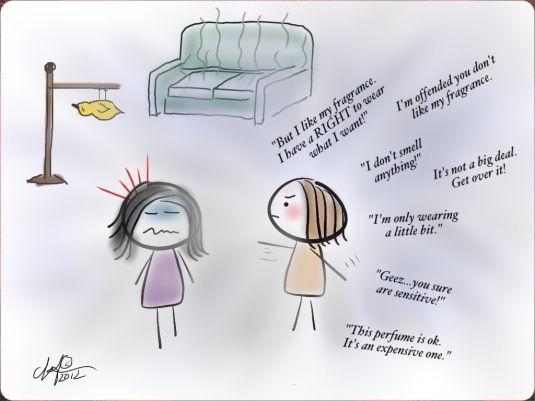
Or
Would you choose the friendship and try to help get your friend away from the problem, or make yourself and your home safe when you are around your friend, regardless of the type of sensitivity they have (food, flowers, environmental, electromagnetic, etc.)?
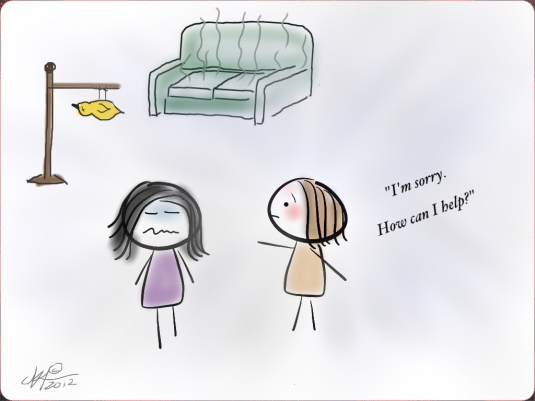
Here are a few fellow bloggers I know of who live with similar sensitivities. If you or someone you know is struggling with chemical or other sensitivities, please feel free to share your experiences in the comments section or let me know if you/they have a blog.
20 Feb 2013
by Fergiemoto
in Uncategorized
Tags: art, creativity, doodles, emotions, encouragement, healing, health, meditation, mind/body, pain, psychology, quotes, sketches
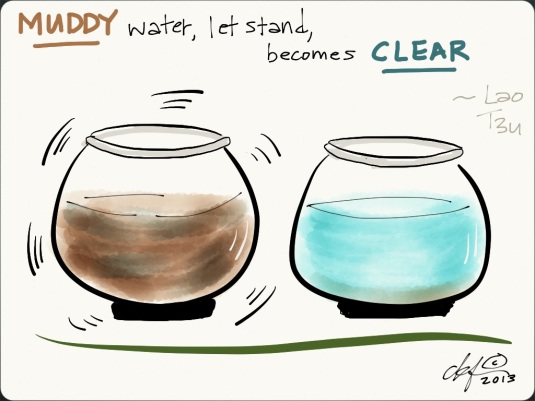
.
Muddy water, let stand, becomes clear. ~ Lao Tzu
Sometimes we just need to take a break to clear our minds or let fresh thoughts and ideas flow in. Here are just a few examples:
- If we are struggling with finding a solution to a problem, it may help to let it rest for a while. Go for a walk or do something else, and return to the problem refreshed rather than continuing to spin our wheels.
- If we are overcome by chronic physical or emotional pain, perhaps a meditative or other relaxing activity will temporarily lessen the intensity.
- If thoughts are racing through our minds, anxiety is elevated, or tempers are flying in a heated interaction, calming down can clear or minimize the turmoil.
- etc.
What are some muddy waters you have faced and what have you done to let it become clear?
08 Feb 2013
by Fergiemoto
in Uncategorized
Tags: art, creativity, doodles, emotions, encouragement, healing, health, mind/body, pain, psychology, quotes, sketches
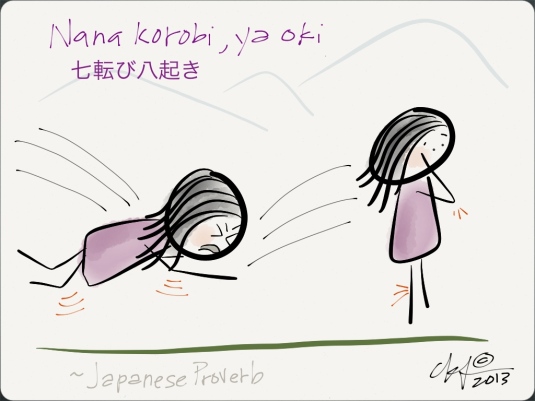
Nana korobi ya oki (七転び八起き) is a Japanese proverb that means, “seven times down, eight times up.”
nana (七) = 7
korobi (転び) = fall down
ya (八) = 8
oki (起き) = get up
It is a saying about perseverance and not giving up no matter how many times you are knocked down. I’ve seen this proverb associated with the Japanese Daruma doll, which is a hollow, round Japanese traditional doll modeled after Bodhidharma, the founder of the Zen sect of Buddhism. These dolls are weighted at the bottom in a way that will always return to an upright position when tilted over.
Never Give Up. May you always get up after a fall.
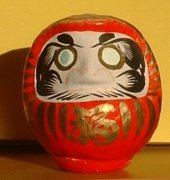
Daruma Doll
Photo courtesy: Wikipedia
20 Nov 2012
by Fergiemoto
in Uncategorized
Tags: art, emotions, haiku, healing, health, meditation, mind/body, nature, pain, photography, photos, poems, poetry, psychology
>>:::<<
a sudden rewind
engulfs me in a whirlwind
flashback
>>:::<<
Do you experience flashbacks of traumatic, sad or other painful events?
A description of flashbacks is:
a psychological phenomenon in which an individual has a sudden, usually powerful, re-experiencing of a past experience or elements of a past experience. These experiences can be happy, sad, exciting, or any other emotion one can consider. The term is used particularly when the memory is recalled involuntarily, and/or when it is so intense that the person ‘relives’ the experience, unable to fully recognize it as memory and not something that is happening in ‘real time.’ Flashbacks are the ‘personal experiences that pop into your awareness, without any conscious, premeditated attempt to search and retrieve this memory.’ (Source: Wikipedia)
I have grouped painful flashbacks as part of the “addressing emotional pain” category because I’ve learned through my pain psychology sessions that they are handled similarly to emotional pain. In previous postings, I included some of the tools that can help with painful emotions, including having an awareness of the body and how it is feeling, physically and emotionally.
Certain situations (events, places, smells, comments, time of year, etc.) can trigger flashbacks. They can be very uncomfortable and lead to feelings like fear, sadness, anxiety, panic attacks, etc. There are a few situations that trigger flashbacks for me. They can go as far as feeling anxiety, and a couple even resulted in panic attacks.
A flashback can feel very real, and your body may think it is a real event. When a flashback occurs, what are some things we can do to get through it? The key thing to remember is that the traumatic event in the flashback is not happening now even though the emotions, fears, and physical responses may be the same. Over time, the reactions to the flashbacks will diminish. Some with take more work than others. The goal is to get to the point where they are “just memories” and that’s it. Here are some things to consider:
- Breathe and practice relaxation techniques
- Allow your body to feel what is happening and have a curious acceptance about those feelings.
- Use some of the tools I’ve talked about to address emotional pain like mindfulness meditation, body awareness, guided imagery, etc. Click here to see more examples.
- Have empathy for yourself and coach yourself through it calmly and objectively. For example, some of the things I’m learning to say to myself are:
- “I wonder what this means.” (This is an important one for me because it involves seeking guidance from our inner advisor, which I’ve also posted about before.)
- “What was the trigger?”
- “I am remembering things very vividly, but it is not happening to me now.”
- “This is uncomfortable, I hate it, but I got through this before and I will get through it again.”
- “It will not kill me.”
- “I have the skills and tools to help me, and I know how to use them.”
Although coping with some of my flashbacks still need more work, there are a few that now carry no emotion, no hurt, and no anxiety if the memories occur…they have gradually become “just memories!”
If you have experienced painful flashbacks, what methods have helped you get through it?
More
31 Oct 2012
by Fergiemoto
in Uncategorized
Tags: acupuncture, alternative medicine, art, chronic pain, craniosacral, creativity, doodles, emotions, haiku, healing, massage therapy, mind/body, psychology, sketches
The guidance in this posting was prepared and provided to me by my Craniosacral Therapist (CST, LMT). She has given me permission to include it in this blog either in verbatim or paraphrased. (FYI – I first posted about my initial experience with CST here.)
My CST has been treating me for many physical issues over the last couple of years including chronic pain in several areas of my body, and recovery from multiple surgeries. Weekly craniosacral and massage therapy sessions from her, regular pain psychology sessions from a licensed psychologist, and periodic acupuncture treatments from a licensed acupuncturist, have provided me with the majority of improvements and answers concerning my recent health issues.
Since the body and the mind are connected, professionals and exercises in both areas are essential for my healing. My CST said it is important to note that she is not a psychologist, and that her work includes how the mind and psyche (such as anxiety, emotions, thoughts, feelings) enter and affect the body physically. Her expertise and treatments have been very helpful for me. The information here is based on her personal experiences and materials she has come across over the years in bodywork trainings, meditation trainings, and teachings she has heard. I thank her for allowing me to include her experiences here. (This image below is a doodle I did to introduce her information.)

.
When you feel a strong emotion arise:
1) Focus on your breath. Connect with the physical sensations of breathing in your body. Do you feel your chest rise and fall, do you feel the breath rush past places in your sinuses or down the back of your throat? Any place you can feel the breath enter and leave, focus there. Your breath is your anchor to the present moment. It’s impossible to breath in the past or future where your mind and/or body often want to go in their remembering or anticipating. To invite yourself fully into the present moment, focus on your breath. Note how your breath feels and what you notice. After noting awareness, invite your breath to gradually become slower, deeper, more relaxed and more regular. I often repeat those four parts to myself when I feel increased anxiety…slower, deeper, more relaxed and more regular. Give yourself several minutes of this practice to slow down. Dr. Andrew Weil teaches this practice as a way to turn off fight or flight response in the body. You may be able to find more information on his website or look for his Breathing: Master Key to Self Healing series.
More
16 Oct 2012
by Fergiemoto
in Uncategorized
Tags: art, chronic pain, creativity, doodles, emotions, encouragement, healing, health, pain, psychology, quotes, sketches

It does not matter how slow you go as long as you don’t stop. ~ Confucius
Many health issues over the last few years, including high chronic pain, have slowed me down significantly. In my healthy heyday, I was constantly on the go and had a good career! Now, I move very slow and am dependent on others to help stabilize me when we leave the house. I feel like I am being left behind in this fast paced world. However, I do have wonderful people closest to me who have stuck with me, supported and encouraged me in many ways, and have slowed their pace to meet mine. This is gold!
Improvements are slow but I am better than I was two years ago. During those times when things get discouraging, it’s important to remember quotes like this. Slow is not bad. It helps one appreciate the things that whizzed by before.
Even if I am moving s l o w l y, it still means there is progress. Remember the story about the tortoise and the hare? In the end, the tortoise won with slow, steady progress.
What are some profound quotes you have handy when experiencing tough times?
04 Oct 2012
by Fergiemoto
in Uncategorized
Tags: art, emotions, haiku, healing, health, meditation, mind/body, nature, photography, photos, poems, poetry, psychology
>>:::<<
volcano surges
lava guided to safe path
disaster averted
>>:::<<
Feeling angry? Have you ever been so angry that you felt like punching something (like this little squirrel appears to be feeling)?
Feeling angry is not bad. Remember, experiencing a variety of emotions depending on our circumstances, is a fact of life. They are going to happen and they need to happen, and are a natural occurrence. Anger is an intense emotion and can carry a great deal of force and energy with it. If we bottle this energy inside us, it will come out later in one way or another, such as lashing out at others or as health problems, for example. A number of tools exist that can help us analyze and express negative emotions, including anger, in a safe and healthy way. Trying to stop the energy from anger may feel like trying to stop a hurricane, but, no, punching someone is NOT ok.
It’s important to recognize that anger is generally a secondary emotion, which I discussed in a previous posting. Anger is usually a response to a primary emotion or situation, and when we analyze our anger, we may discover that there are different emotions and feelings at the core, such as shame, fear, worry, guilt, embarrassment, etc. (If we assume the little squirrel above is angry, what could be it’s primary emotion? Fear, perhaps?)
Previously, I listed a number of tools that I keep in my toolbox to help analyze and address emotions. There are numerous other ways that also exist, and each of us needs to find the tools, or combination of tools that work for us. I’ve listed these before, but here is a handful of tools that may help:
- Managing symptoms by expression:
- Talk out your emotions with a good friend or relative who is willing to listen
- Write about your feelings in a journal or through poetry
- Cry. It is “part of a healthy emotional healing process”
- Express your feelings through art, photography or crafts (like I did with the squirrel photo above)
- Do some kind of exercise like walking, jogging, aerobics, etc., that can use the emotional energy associated with the anger and move it out of your body
- Practice deep breathing exercises; meditate
- Addressing Emotional Pain #2 – Tools
- Addressing Emotional Pain #4 – Secondary Emotions
Finding safe and healthy ways to release painful and negative emotions from our bodies creates space for more positive emotions to move in, and more peace within our life.
.
What are some of the ways you have found to help manage anger?
.
Related article(s):
- Anger – Recovery Thru My Lens
More
16 Sep 2012
by Fergiemoto
in Uncategorized
Tags: art, emotions, haiku, healing, health, meditation, mind/body, nature, photography, photos, poems, poetry, psychology, quotes
.
The Master observes the world
but trusts his inner vision.
He allows things to come and go.
His heart is open as the sky.
~ Lao Tzu
>>:::<<
a resonating voice
soundless yet influential
listen and trust it
>>:::<<
Have you ever looked inside yourself to find answers to your questions, whether it’s help with a problem, a project, making decisions, finding out what’s behind some of our health issues and what we need to heal, determining the reason for certain recurring memories, or even why some situations seem to trigger strong emotions, etc.? Our questions can involve a variety of issues, and sometimes the answers you receive can be very surprising, as depicted in my photo above.
Those who understand or practice mind/body exercises like meditation or guided imagery probably understand how important it is to consult and trust our inner voices, ie., tapping into our subconscious for help (also referred to as our “inner advisor” or “inner physician” – I like to use the term “inner advisor,” which I introduced in my posting here about a year ago ). This also helps build and strengthen our intuition. More
14 Aug 2012
by Fergiemoto
in Uncategorized
Tags: art, encouragement, healing, health, macro, nature, photography, photos, psychology, quotes
>>:::<<
Never discourage anyone who continually makes progress, no matter how slow.
~ Plato
>>:::<<
Check out the left foot on this scrub jay. It is deformed but he carries on regardless of how limiting it may be. I’ve noticed he has more difficulty perching on the bird feeders than his mate.
As for me, I am gradually healing. It is slow and there have been bumps in the road, both large and small, but there is still progress. Even small successes are definite reasons to celebrate. Also, sorry for the long delay since my last posting, and thank you for being patient.
This post is in response to a blogging challenge by Robin in her blog, “Bringing Europe Home” where she hosts a periodic blogging challenge called “Quotes from the Masters.” These quotes can be used as inspiration for your own interpretation whether it be a photo, story, poem, song, etc. I thought the Plato quote fit well in this blog.
Linking up with:
MACRO MONDAY
WILD BIRD WEDNESDAY
NATURE NOTES
24 Jun 2012
by Fergiemoto
in Uncategorized
Tags: art, creativity, emotions, healing, health, mind/body, mindfulness, pain, psychology, quotes
To see things in the seed, that is genius. ~ Lao Tzu
In a previous post I listed some tools to help address emotional pain. One of those tools I learned is creating artwork that represents what you are feeling, such as a drawing, painting, sketching, doodling, photography, etc. It doesn’t have to be fancy and you don’t have to be an artist. The important point to remember is that the energy associated with painful emotions needs an outlet, instead of becoming trapped in the body. Just try to get it out of you. Stopping, distracting, dismissing or suppressing these emotions can surface later in other, potentially harmful ways.
When you create your “emotion” artwork, ask yourself a couple of questions. “What does this picture mean?” “What is it trying to tell me?” It may depict a primary feeling at first, such as sadness, anger, fear, etc. But try to dig deeper and notice other feelings that arise. Don’t be content with the first emotion you are creating because this could help reveal core issues that need to be addressed.
Look at the following doodle for example. Have you ever felt down or discouraged, like you were in a deep hole and didn’t know how to climb out? If this were one of your doodles, what are your initial feelings? Is it hopeless, overwhelmed…? If you dig deeper, what are other feelings that arise? List them…is it sad…lonely…frustrated…angry…isolated…irritated, etc…? The face may not depict all the emotions, but dig deeper. Notice what else you are feeling. More
10 Jun 2012
by Fergiemoto
in Uncategorized
Tags: art, haiku, healing, health, nature, photography, photos, poems, poetry, psychology
>>:::<<
no fences to confine
yet unable to soar great heights
acceptance
>>:::<<
Recently, we visited a local aviary that had two resident golden eagles, this being one of them. At first, we found it odd that their exhibit was in the open, with no fencing to keep them from flying away. There was only a short fence to keep visitors at a distance. Then we read the information posted about them. Both eagles had lost one of their wings in the wild and were unable to fly, and unable to leave. The eagle in this photo kept trying to fly, though. Each time, it would position itself for takeoff, spread it’s wing, jump off the log, crash hard to the ground, and clumsily pick itself up and jump back on the log. The other eagle did not attempt to fly while we were there. These eagles will never be able to soar majestically to great heights again…at least not on their own.
Regardless of how hard we try, there are things we may never be able to do again, whether the restriction is physical, or the risk of physical or emotional injury far exceeds the benefits of persisting. There may also be other stressful situations in our life that are out of our control and that we are unable to change. Although difficult, acceptance is key. Then we can decide what to do about the situation, and determine the best course of action that allows us to move forward in a healthier way.
What are some things you have had to accept?
17 May 2012
by Fergiemoto
in Uncategorized
Tags: alternative medicine, art, flowers, healing, health, nature, photography, photos
Recently, we visited at a local botanical garden where we saw these lovely, colorful Pasque flowers in it’s Medicinal Garden section. The blooms and seed heads were mingled with each other creating a nice contrast to me. As I was taking photos, we saw the following sign next to the flowers:
 .
.
Interesting. I had not heard of Pasque Flower before, so later, I looked it up on Wikipedia. Pasque refers to Easter, and the flower blooms in early spring. It also states Pulsatilla have been used to treat reproductive problems, and that the plant “is highly toxic, and produces cardiogenic toxins and oxytoxins which slow the heart in humans…” Also, Drugs.com refers to Pasque flower as “extremely toxic and should not be ingested or applied to the skin.” Such a pretty flower, and it sounds like one needs to be very careful around this plant.
Related articles:
Previous Older Entries






















